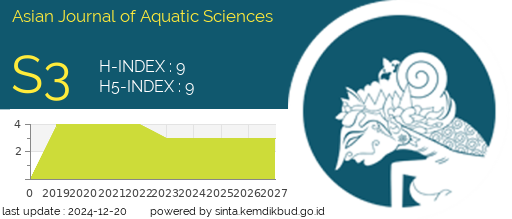COASTAL VULNERABILITY ANALYSIS IN DUMAI BARAT DISTRICT
DOI:
https://doi.org/10.31258/Keywords:
Dumai, Coastal Vulnerability, Geological Variables Quantitative DescriptiveAbstract
The Coastal area is an area that is very vulnerable to the phenomenon of natural change. The coastal area's vulnerability level is influenced by geological variables, namely coastal geomorphology, sea level rise, shoreline changes, tides, and coastal elevations. This research was conducted in October 2021. This study aims to determine the level of coastal vulnerability in the Dumai Barat Sub-District, Riau Province with a quantitative descriptive method. Based on the result of the study, the coastal vulnerability index can be classified into five categories: very not vulnerable, not vulnerable, medium, high, and very high. The coastal area of Dumai Barat District is categorized as low vulnerability.
Downloads
References
1. Dahuri R, Rais J, Ginting SP, MJ Sitepu. Integrated management of coastal and marine resources. PT Pradnya Paramita: Jakarta, 2001.
2. Wahyudi, Hariyanto T, Suntoyo. Coastal vulnerability analysis in the north coast of East Java. Ocean Engineering Department. ITS Surabaya, 2009.
3. Kaly U, Pratt C, Mitchell J. The environmental vulnerability index (EVI) (SOPAC Technical Report 384), 2004.
4. Agustin S, Syamsidik S, Fatimah E. Assessment of the physical vulnerability index of the west - south coast of Aceh. Journal of Civil Engineering, 2016; 5(1), 71–80.
5. Susilo SB. Small islands development sustainability index (BPK) with multiple criteria imprints (SKG). Coastal and Ocean Journal, 2006; 7(2): 52-70.
6. Gornitz V. Global coastal hazards from future sea-level rise. Palaeogeography, Palaeoclimatology, Palaeoecology (Global and Planetary Change Section), 1991; 89(4): 379–398. https://doi.org/10.1016/09218181(91)90118-g.
7. Sulma S. Coastal vulnerability to sea level rise (case study: Surabaya and its surroundings). Thesis. University of Indonesia: Depok, 2012: 131 p.
8. Natural Hazard Observer. Social vulnerability and capacity. Institute of Behavioral Science University of Colorado at Boulder 482 UCB Boulder, Colorado, 2007; XXXII (2):24 p.







